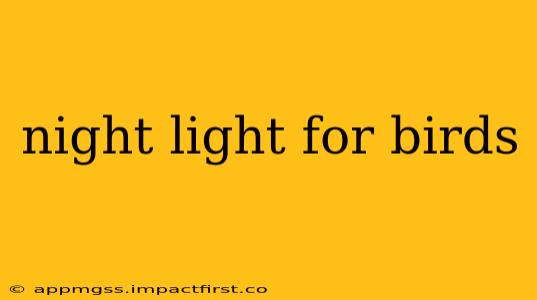The twinkling lights of human civilization can have a devastating impact on birds. Artificial light at night (ALAN) disrupts their natural behaviors, impacting migration patterns, foraging, breeding, and overall survival. While we strive for safety and convenience, understanding the effects of night lighting on birds is crucial. This guide delves into the challenges ALAN poses to birds and explores solutions, including the use of bird-friendly night lights.
Why Do Birds Need Protection from Night Lights?
Birds rely on natural light cues for many essential life processes. Artificial light can:
- Disrupt Migration: Migratory birds use celestial cues (stars, moon) for navigation. Bright lights can confuse them, causing them to stray off course, exhaust their energy, and become vulnerable to predators or collisions with buildings.
- Alter Foraging Behavior: Nocturnal birds rely on darkness for hunting. Artificial light can reduce their hunting success, affecting their ability to find food and survive.
- Impact Breeding Cycles: Light pollution can interfere with birds' breeding cycles, affecting their reproductive success.
- Increase Predation Risk: Bright lights can attract nocturnal predators, increasing the risk for birds.
- Cause Collisions: Birds may collide with brightly lit buildings and structures, resulting in injury or death.
What are Bird-Friendly Night Lights?
The key is to minimize light pollution's negative effects. Bird-friendly night lights are designed to reduce the impact of ALAN on birds. While no single “bird-friendly” standard exists, these characteristics generally apply:
- Low Intensity: Dim light reduces the disorienting effect on birds.
- Shielded: Shielded lights direct illumination downwards, preventing upward light spill that can confuse birds.
- Warm Color Temperature: Amber or red light is less disruptive to birds than white or blue light, which is more intensely perceived by their eyes.
- Motion Sensors: Motion-sensor lights only illuminate when necessary, reducing overall light pollution.
- Minimal Brightness: The light should only be bright enough to illuminate the necessary area.
What are the Different Types of Bird-Friendly Night Lights?
Several options cater to varying needs and preferences:
- Low-Intensity LED Bulbs: LED bulbs are energy-efficient and can be selected with low wattage and warm color temperature (e.g., amber or red).
- Motion-Sensor Lights: These lights only turn on when motion is detected, reducing light pollution during periods of inactivity.
- Shielded Outdoor Lighting Fixtures: Specifically designed to direct light downwards, minimizing light trespass.
How Can I Make My Outdoor Lighting Bird-Friendly?
- Choose the Right Bulbs: Opt for low-intensity LED bulbs with a warm color temperature.
- Install Lights Strategically: Place lights only where necessary and shield them to direct light downwards.
- Use Motion Sensors: Implement motion sensors to minimize unnecessary illumination.
- Turn Off Lights When Not Needed: This simple act drastically reduces light pollution.
- Consider Planting Trees and Shrubs: These can help to naturally block or diffuse light.
How to Choose the Right Night Light for Birds?
Consider these factors when selecting a bird-friendly night light:
- Color Temperature (Kelvin): Aim for a lower Kelvin rating (e.g., 2700K or less), representing warmer colors.
- Lumens: Select a lower lumens output for minimal brightness.
- Shielding: Look for lights with fully shielded designs.
- Motion Sensors: Consider motion-sensor lights for energy efficiency and reduced light pollution.
What are the Potential Alternatives to Traditional Night Lights?
Beyond choosing bird-friendly lights, consider these alternatives:
- Solar-Powered Pathway Lights: These lights use solar energy, reducing reliance on electricity.
- Moonlighting: Create a softer, less disruptive nighttime environment by mimicking natural moonlight.
- No Lights at All: In many cases, eliminating outdoor lighting altogether is the most bird-friendly option.
Are There Any Studies Showing the Effectiveness of Bird-Friendly Night Lights?
While specific studies solely focused on "bird-friendly" night lights are limited, extensive research links ALAN to negative avian impacts. Studies on reduced light intensity, shielded lighting, and warmer color temperatures consistently show positive results in reducing these impacts. The principle is to minimize the light's overall effects on birds' natural behaviors.
By understanding the challenges posed by artificial light at night and actively choosing bird-friendly alternatives, we can contribute to the protection of these vital creatures and their ecosystems. Making small changes to our lighting choices can have a significant positive impact on avian wildlife.
